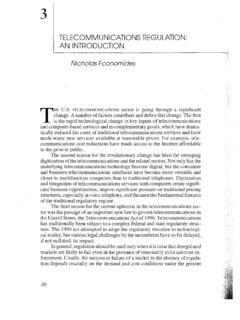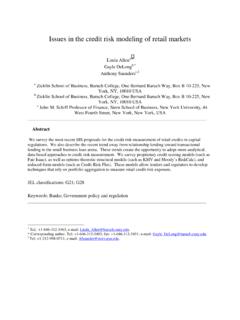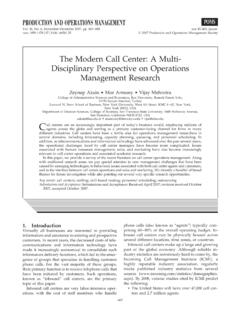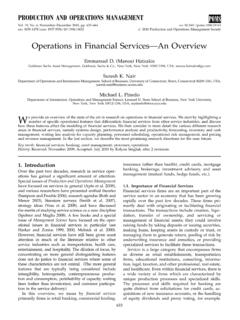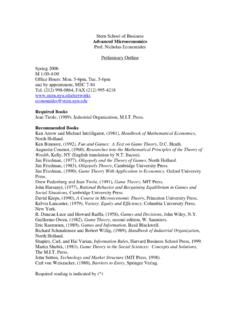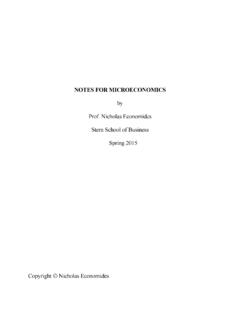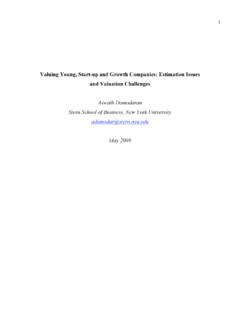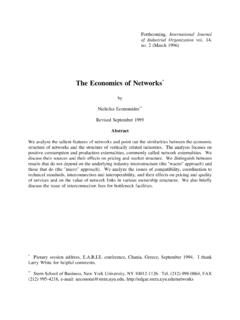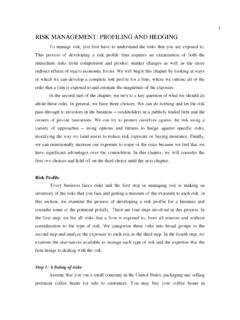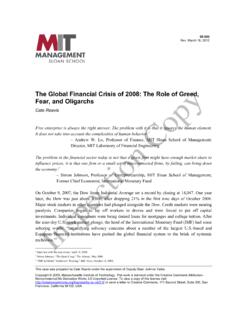Transcription of ESG AND FINANCIAL PERFORMANCE - New York University
1 ESG AND FINANCIAL PERFORMANCE : Uncovering the Relationship by Aggregating Evidence from 1,000 Plus Studies Published between 2015 2020By Tensie Whelan, Ulrich Atz, Tracy Van Holt and Casey Clark, CFA2 ESG and FINANCIAL PerformanceMeta-studies examining the relationship between ESG and FINANCIAL PERFORMANCE have a decades-long history. Almost all the articles they cover, however, were written before 2015. Those analyses found positive correlations between ESG PERFORMANCE and operational efficiencies, stock PERFORMANCE and lower cost of capital. Five years later, we have seen an exponential growth in ESG and impact investing due in large part to increasing evidence that business strategy focused on material ESG issues is synonymous with high quality management teams and improved returns.
2 A case in point: A recent study looked at the initial stock market reaction to the COVID-19 crisis (up to March 23) and found that companies scoring high on a crisis response measure (based on Human Capital, Supply Chain, and Products and Services ESG sentiment) were associated with higher stock returns (Cheema-Fox et al., 2020). Nevertheless, the topic continues to be debated, with some arguing that companies and investors should stick to managing for stock price and that ESG is, at best, a distraction from the real business of making money. The authors of this report, NYU Stern Center for Sustainable Business and Rockefeller Asset Management, collaborated to examine the relationship between ESG and FINANCIAL PERFORMANCE in more than 1,000 research papers from 2015 2020.
3 Because of the varying research frameworks, metrics and definitions, we decided to take a different approach than previous meta-analyses. We divided the articles into those focused on corporate FINANCIAL PERFORMANCE ( operating metrics such as ROE or ROA or stock PERFORMANCE for a company or group of companies) and those focused on investment PERFORMANCE (from the perspective of an investor, generally measures of alpha or metrics such as the Sharpe ratio on a portfolio of stocks), to determine if there was a difference in the findings. We also separately reviewed papers and articles focused on low carbon strategies tied to FINANCIAL PERFORMANCE in order to understand FINANCIAL PERFORMANCE implications through the lens of a single thematic issue.
4 We found a positive relationship between ESG and FINANCIAL PERFORMANCE for 58% of the corporate studies focused on operational metrics such as ROE, ROA, or stock price with 13% showing neutral impact, 21% mixed results (the same study finding a positive, neutral or negative results) and only 8% showing a negative relationship. For investment studies typically focused on risk-adjusted attributes such as alpha or the Sharpe ratio on a portfolio of stocks, 59% showed similar or better PERFORMANCE relative to conventional investment approaches while only 14% found negative results.
5 We also found positive results when we reviewed 59 climate change, or low carbon, studies related to FINANCIAL PERFORMANCE . On the corporate side, 57% arrived at a positive conclusion, 29% a neutral impact, 9% mixed and, 6% negative. Looking at investor studies, 65% showed positive or neutral PERFORMANCE compared to conventional investments with only 13% indicating negative findings. A detailed breakdown can be found in Figure findings were supported by an additional meta-meta-analysis (a study of existing meta-studies) we undertook. We found 13 corporate meta-analysis studies published (covering 1,272 unique studies) with a quantitative approach and 2 investor meta-analysis studies (covering 107 unique studies) published since 2015.
6 The former found consistent positive correlations between ESG and corporate FINANCIAL PERFORMANCE ; the latter found that ESG investing returns were generally indistinguishable from conventional investing returns. (Figure 2). We concluded that these two findings are robust across time and Summary3 ESG and FINANCIAL PerformanceResearch over the last five years appears to be producing more conclusive results, but it is worth acknowledging the challenges with inconsistent terminology, insufficient emphasis on material ESG issues, ESG data shortcomings, and confusion regarding different ESG investing strategies.
7 Research covering ESG and FINANCIAL PERFORMANCE often suffers from inconsistent terminology and nomenclature. Meuer et al. (2019) found 33 definitions of corporate sustainability in usage. For corporations, embedded sustainability (ESG is part of the business strategy) may have different PERFORMANCE implications than traditional Corporate Social Responsibility (CSR) efforts that emphasize community relations and philanthropy, yet there has been insufficient review of those differences, creating noise in the findings (Douglas et al., 2017). We see some of that confusion in a study by Manchiraju and Rajgopal (2017) which assessed the (poor) FINANCIAL PERFORMANCE of companies required to spend 2% of their profits on CSR by the Indian government.
8 In this case, CSR was philanthropy and community relations, not sustainability related to the material ESG issues that could enhance long-term PERFORMANCE . Research often fails to distinguish between material and immaterial ESG issues as well as ESG leaders versus improvers. For example, Khan et al. (2016) demonstrate the alpha potential when incorporating material ESG issues, with the stock PERFORMANCE of companies focused on material issues outperforming those that focuses on immaterial ESG issues or no ESG issues at all. Rockefeller Asset Management s research shows similar results: one study emphasizes that ESG integration will increasingly be demarcated between Leaders and Improvers and finds long-term alpha enhancing potential when focusing on material ESG issue improvement (Clark & Lalit, 2020).
9 The results are also complicated by the lack of standardization with ESG data. Studies use different scores for different companies by different data providers. Eccles et al. (2017), for example, reviewed a global survey of institutional investors and concluded that the biggest barrier is the lack of high quality data about the PERFORMANCE of companies on their material ESG factors. Plenty of technical evidence also points to the shortcomings of accounting metrics and ESG data (Berg et al., 2019). We found that at least 40% of studies relied on an overall, third-party ESG score.
10 ESG integration, ESG momentum, decarbonizing, socially responsible investing (SRI), negative screening, and impact investing are just a few of the varied approaches referenced in the research. They are often merged together, even though each has different risk-reward implications . A common research approach is to query Bloomberg for funds labeled ESG those funds are self-designated, and may lack a robust ESG investing framework. Studies can also confuse the outcome by failing to distinguish between PERFORMANCE of a strategy seeking market rate or excess returns versus a strategy prioritizing positive environmental and social impact while accepting concessionary We drew six conclusions about the relationship between ESG and FINANCIAL PERFORMANCE after examining the 1000 plus individual studies.
